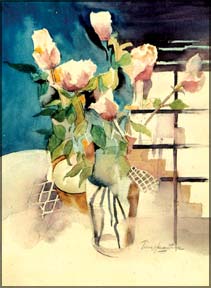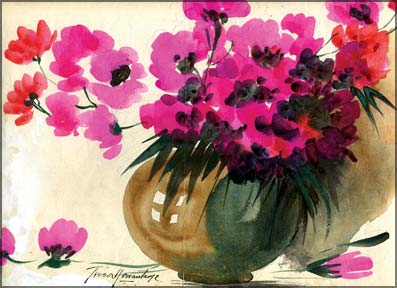Painting flowers and plants
Tissa HEWAVITARANE
I was brought up surrounded by the beautiful garden which my father
created, so I suppose it was inevitable that sooner or later I would
develop some interest in the flowers and plants which grew in such
abundance around me.
Since childhood my paintings and drawings have always been extremely
detailed. At school I remember my art teacher telling me to go home and
draw a cooker, presumably with the idea of encouraging me to paint more
imaginatively and thus more fludidly - it did not work! kitchen
implements produced no emotion in me whatsoever.

A painting can be as detailed or as abstract as you like, but without
some sort of emotion and depth of feeling from its creator, it will
always lack Ďlifeí.
Today, flowers, plants and fruits remain as popular a subject as ever
and their ready availability make them the ideal subject for both
professional and aspiring artists. The wealth of subject matter they
provide is infinite.
Masses of nw varieties and specimens are continually appearing on the
market, and my visits to flower shows in Colombo never fails to make my
heart leap with excitement.
Methods of painting
Chinese and Japanese have traditionally practised a somewhat stylised
method of painting flowers. By using economical motifs they portray in a
masterly fashion the essence of flowers with a few simple strokes of the
brush. In the west, however, the approach has generally been more
naturalistic.
Originally it was the medicinal powers of wild plants which prompted
people to study them; hence the need for close attention to detail.

There was also considerable interest in flowers and herbs in the
Elizabethan era. The eighteenth century was the hey day of the flower
painter, producing such distinguished names as Georg Ehret, Pierre
Joseph Redoute, the Bouer brothers and Pirre Jean Turpin, to name a few.
By the nineteenth century, botany was a favourite pastime and young
ladies often spent their leisure time painting flowers. Flowers are so
attractive, itís hard to resist the urge to paint them in every detail.
Painting flowers requires close observation to detail and constant
practice.
However, the most essential thing is knowing how to interpret
creatively the particular character of flowers you have chosen to paint
whether they be huge exotic lilies or tiny, dainty dew-drops.
Setting up
Try to keep the arrangement of your flowers simple and informal.
Stylized or symmetrical groupings tend to look stiff and unnatural in a
painting. Most of us have experienced the frustration of setting out to
capture the elusive beauty of flowers.
Arrange the blooms so that they overlap each other, and include
profile, and back views of some of them. This add variety of shape as
well as accentuating the three dimensional impression.
A vase fill of multicoloured flowers is not always a good idea,
because the colours fight each other and destroy any impression of
delicacy. Itís far better to choose flowers of the same colour, or a
harmonious arrangement of closely related colours.
Mixing colours
Freshness and clarity of colour are essential in flower painting, so
be sure that you are familiar with your colours and how they mix
together. Flowers may be colourful, but you donít need a vast aray of
colours in order to paint them.
In fact, a simple palette often produces the best results, because it
is likely to be more harmonious. When choosing your colours, avoid the
more opaque one such as yellow ochre in favour of the rally transparent
ones like alizarin crimson, lemon yellow and rose dore. When mixing
colours, donít use more than two or three pigments, otherwise the colour
will turn muddy and opaque.
For maximum vibrancy, build up the forms of petals and leaves, with
thin glazes of warm and cool colour that allow light to reflect off the
paper.
Flowers are natural living things, and should be painted as such.
Observe the two paintings (still-life) I have done.
I have chosen one set of flowers and used one colour only. The
flowers by the window show the flower forms are built up from light to
dark with glazes of warm and cool colour. Spontaneous brush strokes and
lost and found edges give a sense of natural, living forms.
I have used delicate pink to adorn them against the backdrop of
turquoise blue, as colour contrast.
The other vase, with single flowers depicts a brighter pink with dark
green leaves. Note the flowers that grow in the wild have simple charm
that is perfectly captured in this delightful study. Observe the harmony
of bright pink used throughout, as a single colour providing a focal
point. Compare the light, airy quality of the background washes from
dark to light.
Flowers are very delicate in colouring, so try not to overwork them
too much.
Plants
I hope to encourage you to share some of my enthusiasm for plants,
and herbs which grow in the garden. Once you start look at plants really
closely, your natural curiosity will urge you to find out more; how
plants are structured; how and where they grow; how they are fertilized
and die.
Look around you and then look again. Study the colours, observe the
changes in colours and textures. Study the blossoms in various seasons.
Look at the subtle greens of herbs. As with most painting subjects,
there is a sense of urgency when painting plants. The lifespan of most
flowers and plants being such that it is difficult to paint the whole
group or bunch in detail in one go. I start by deciding what I want to
paint.
Use of colour
As my work often requires extremely delicate washes of colour, I try
always to use colours that do not fade.
Colours play such a crucial part in the accurate portrayal of plants
that I make certain that the colours mixed on the palette are correct
before applying them to paper. I next test each colour on a rough sheet
of paper identical to that I intend using for the final painting, as the
different absorbency levels of paper can affect colours. Next I change
the water regularly to keep the colours as fresh and pure as possible.
The colours I use most often to paint flowers and plants are scarlet
lake, vermilion, lemon yellow, burnt umber, burnt sienna, vandyke brown,
Hooker green, ultramarine blue to name few. For detail work I use, No.
1,2, and 3 sable hair brushes and for washes No. 8 or 12. Look carefully
you will find the garden can be an exciting source of painting material
as well as a constant source of pleasure and culinary delights all the
year round.
www.tissahewavitarane.com
|

